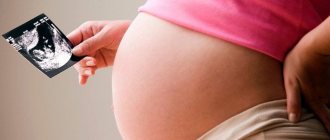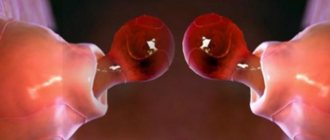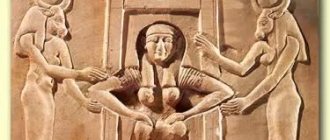At what time do the first tremors appear?
It's hard to believe, but in fact, the baby begins to move in the stomach much earlier than you can feel it. It’s just that at first he is so small that the flapping of his arms and legs cannot be felt.
Mothers who are expecting their first child most often feel kicks for the first time at 20–23 weeks. By this moment, the baby inside has already gained enough weight, becomes stronger, and he finally manages to “reach out” to his mother.
Women expecting their second or third child are more observant and sensitive to his movements, so they manage to track the kicks much earlier - around the 16th week.
There is another reason why a woman may feel movements prematurely - expecting twins. In this case, tremors occur at 15–16 weeks and are intense and widespread.
It’s easy to confirm your guess using an ultrasound.
Dynamics of child activity at different stages
Doctors note that the baby is most active at 6–7 months of pregnancy, then its movements become more orderly.
Before this, the kicks are felt weaker due to insufficient muscle strength of the child. They are more reminiscent of light touches, tickling or even rumbling in the stomach.
In the last month, the baby becomes so big that he cannot move freely in the uterus and do whatever he likes.
The period of activity is the most difficult for the mother. If early tremors are perceived with emotion, then at this stage they can seriously interfere with a woman’s rest and sleep.
Nesting instinct on the eve of childbirth
On the eve of childbirth, many women receive another “news” from nature that the baby will be born very soon. An indomitable desire arises to prepare him a cozy “nest” and the expectant mother with great pleasure chooses tiny socks and baby vests for her future son or daughter, embroiders diapers, knits a hat and blanket, buys the softest and most beautiful bed linen for the crib, a comfortable stroller, a warm envelope, a lace blanket, a set of bibs and that nice little rattle! Another obligatory item of “building a nest” is often general cleaning (or even repairs). Having set up a children's corner, bought things and “cleaned” the house, the woman breathes a sigh of relief: she can give birth. And... it is at this moment that contractions often begin. “Nesting” is an incredibly happy time, because it reminds you that your dream of meeting your baby soon is about to become a reality!
Siblings' experience
Nena
– About two days before giving birth, she became more active - both times she began large cleanings throughout the entire apartment, which she had no longer had the strength to do for a long time. I paid attention because I read here on the forum that this happens - preparing a nest. And there were no more warning signs.
Ekaterina
– At 39 weeks 5 days I woke up with a terrible surge of energy and decided that it was simply vital to rip out all the floors in the house. Then I realized that it would start at night.
Enya
– I didn’t have any special feelings before giving birth, except that I, like a field mouse, had been dragging all the groceries home from the store for the last 10 days. Well, I couldn’t pass by the store. I take a full bag and drag it, then I realize that I can’t carry it, it’s hard, so I catch a taxi. Twice I came home by taxi with string bags.
What affects a child's activity?
The nature of the tremors and the “schedule” are purely individual for everyone.
The intensity of movements is also influenced by the baby’s temperament. As well as the amount of amniotic fluid, characteristics of the woman’s body, fetal presentation and much more.
But the mother herself can largely influence the baby’s activity. For example, women who lead an active life during pregnancy and do gymnastics are less concerned about tremors. The child is lulled by uniform movements, and he calms down.
But when the mother is motionless, the baby obviously tries to remind him of his existence and begins to push again. Therefore, you should be prepared for unplanned night awakenings: the baby will not let you relax.
The child is trying to contact his mother, he feels her mood and responds to it.
A nervous state during pregnancy also affects the movements of the fetus. The more experiences you experience, the more active the tremors. This is why it is so important to avoid worries and worries during this period - all this is reflected in your baby.
In addition, the mother’s consumption of a number of foods, including sweets, affects the increase in activity. Whether this is connected with children’s innate love for sweets, with receiving an influx of energy, or with an attempt to protect the mother from excess calories is unknown - but the fact is a fact.
Changes in well-being and mood
All changes in a woman’s body on the eve of childbirth are associated with hormonal changes. At the beginning of pregnancy, the body's main task was to preserve and take care of the safety of the baby. The “boss” of this process was the hormone progesterone, which is produced by the placenta during pregnancy. Towards the end of the third trimester, the placenta begins to age and progesterone levels gradually decrease. Now the first violin is played by the female sex hormones estrogens, the level of which increases as the placenta ages and the baby functionally matures. It is estrogens that are “responsible” for softening the cervix, stretching the ligaments and increasing the sensitivity of the uterus, promoting its contraction. Such a hormonal “storm” can affect your mood, causing either sudden tears or bursts of joy. In addition, in the last weeks before giving birth, a woman prepares for serious changes, fears the upcoming birth, in a word, leads a rich emotional life. Treat your changing mood with understanding, because such mood swings are also part of the preparation for one of the most important meetings in life!
Siblings' experience
Cheshire Cat
– The mood before childbirth changes in the direction that you want to kill everyone who even hints at the topic “well, when already.” And in books, by the way, they often write that one of the signs of an approaching birth is hormonal changes, accompanied by mood changes and a feeling of how tired everything is, no strength, fatigue from a feeling of uncertainty, impatience - when the birth is finally here! There is probably something in this; you really look forward to childbirth as if it were a holiday. But when the contractions begin, there are no more previously tormenting fears, and one thought - well, thank you, God - it has begun!
Changes in well-being and mood. Expert commentary
A few days before giving birth, changes in the well-being and mood of the expectant mother may occur. Some people are concerned about tearfulness, rapid mood swings, irritability, and emotional upsurge. In addition, severe sweating, chills, fever, and dizziness may occur. Such symptoms are caused by hormonal changes in the body of a pregnant woman on the eve of childbirth. It is important to understand that the precursors of labor at 37-40 weeks are not yet the beginning of labor. However, if you feel such symptoms, you should not ignore them. Be sure to tell your doctor about them.
Why is it necessary to monitor your child's movements?
Doctors recommend keeping a calendar and noting there all changes associated with the activity of the fetus. Thanks to them, it is possible to obtain information about its condition, for example, what position it is in.
If the tremors are felt in the upper part of the abdomen, it lies head down; if in the lower part, the baby is in a breech position.
Of course, the movement of a child is a very individual process, and yet it has its own norms and deviations. Don't worry if the baby doesn't make itself known for several hours - he may simply be sleeping.
But if the immobility drags on, this is a reason to be wary. You need to try to motivate the baby through physical exercise and eating sweets.
When should you see a doctor?
Minor movements should normally be regular; as a rule, the baby is “at the peak of activity” up to ten times a day.
This condition may be associated with serious diseases that need to be diagnosed urgently. Doctors prescribe ultrasound and CTG to identify the cause.
Most often it is hypoxia, which, in turn, is caused by various complications and diseases in both the mother and the fetus. Among them are cardiovascular diseases, anemia, diabetes, abnormal position of the fetus in the uterus and more. With oxygen starvation, excessive activity is most often replaced by lethargy of tremors. If the diagnosis is confirmed, pregnancy should proceed under close medical supervision.
If the movements are intense
The same applies to too intense movements of the fetus, which cause pain and discomfort to the mother. Excessive mobility is not good for the child: he can get wrapped in the umbilical cord and harm himself.
It is normal to experience discomfort with kicks in the later stages. You can try to calm your naughty boy by lulling him to sleep.
Remember that through pushing your baby conveys information to you, this is the only way he can tell you that he is not feeling well and is missing something.
Yes, complications do happen, but don’t panic too much after every baby’s movement. Worrying will only increase his anxiety. It is better to keep track of his “messages” and keep a pregnancy diary with joy and peace. Think how interesting it will be, many years later, for both you and the already matured inhabitant of your tummy to remember this first experience of communication.
Source: mama.neolove.ru
Causes of abdominal pain during pregnancy
So, yesterday we started discussing the issue regarding the occurrence of such a symptom as abdominal pain.
A discussion began about the causes of pain of various origins, both related to pregnancy itself and not dependent on it. Let's continue to look at the main reasons for the development of pain that may bother the expectant mother. Pain in the pubic area
Over the course of nine months, a pregnant woman’s body constantly secretes a special hormone - relaxin, which has a certain effect on the ligaments and cartilage, the area where the bony pelvis is connected. As a result of the action of this hormone, some joints in the area of the pelvic bones soften and diverge, in particular in the pubic area, the area of the pubic symphysis (a special cartilaginous bridge between the joint of the pelvic bones) diverges somewhat. This pubic symphysis is capable of expanding slightly, within one centimeter, to increase the size of the pelvic bone ring and subsequently facilitate the passage of the baby’s head and body through it during childbirth.
Often the bones in the area of the pubic symphysis diverge and form a gap, which can cause pain of varying intensity in the pubic area, in the projection of the pubic symphysis. Pain sensations can range from barely noticeable heaviness to quite pronounced pain and a feeling of pressure on the pelvis, especially pronounced in an upright position. Pain can also occur when walking or changing body posture, moving in space from horizontal to vertical, when walking up stairs and raising legs while standing. To relieve such pain, wearing a prenatal bandage that supports the uterus and baby in an elevated state, while using a soft chair or exercise ball (fitball), can help.
Osteopathic doctors can help if such pain occurs; they relieve pressure on nerves and muscles. Women perceive pain differently due to the fact that the degree of relaxation of ligaments and joints is different, and the pain sensitivity threshold is different for everyone. In addition, expectant mothers experience anxiety and fear, which increases negative feelings and makes the pain seem stronger. In any case, if pain occurs in the pubic area or above it, you should consult a doctor.
Tension in the abdomen
Around the middle of pregnancy, and more often by the beginning of the third trimester, a pregnant woman experiences a feeling of tension in the lower abdomen, and the uterus hardens and becomes tense. It becomes as if “stone”, and it is difficult to feel the baby through the wall. Such stress can last from a few seconds to a couple of minutes, and can be repeated up to ten times a day without any frequency. These are called training contractions or otherwise called Breston-Gix contractions.
The sensations do not bring pain as such, just an unpleasant feeling of compression and compaction, however, despite the practically painlessness of this event, it greatly worries the expectant mother. It is worth remembering that such training contractions are not dangerous, they prepare the uterus for further normal contractions and train the muscle elements to actively work. But, if contractions become painful, frequent and repeat after a certain time interval - 20-30 minutes or more often, you must immediately go to the hospital - this may be the beginning of premature labor.
Pain when the child moves
From the second half of pregnancy, the baby's growth becomes very active and rapid, and the mother already clearly recognizes his movements in the uterine cavity. As the child grows, it becomes more and more cramped in it, and he lacks active space for movement. The child begins to move not as intensely as it was before, but at the same time the strength of his pushes and movements increases. The baby moves his arms and legs, moves his head, and the mother clearly feels his movements inside her body, and sometimes his movements can even be painful. The baby’s kicks in the area under the ribs, especially in the right side where the liver is located, can be especially unpleasant and sensitive, and the kicks in the lower abdomen can also be sensitive, especially with a full bladder. The sensations range from oppressive to painful, depending on the strength and duration.
These phenomena are quite natural and should not cause you any concern, although a large baby from a rather slender mother may quite painfully “beat” her ribs and stomach with her legs. If particularly sudden and strong movements occur, you should try to change your position - you can tilt your head down, stand on your feet or sit down, lie on your side, turn over so that the baby slightly changes its position in the uterus. You should also relax and take a few deep breaths and exhalations, you can stroke your belly and talk to your child, asking him to calm down. Often these actions are enough to calm the child. If the child’s movements are unnaturally strong, and he is constantly restless in your stomach, you should consult a doctor and determine whether the child has signs of hypoxia (oxygen starvation).
Signs of a threatened pregnancy
Abdominal pain during pregnancy is not always harmless; often manifestations such as abdominal pain are symptoms of dangerous and serious diseases, which require immediate medical attention and intensive treatment to prevent miscarriage. Often the appearance of abdominal pain, especially in the lower and lumbar area, is a symptom of a threatened miscarriage, which can lead to spontaneous miscarriage or the onset of premature labor when the baby is not yet ready to be born.
Miscarriage or premature birth does not occur suddenly; provoking factors may act in the initial stages - stress, physical tension, negative emotions, which leads to the release of a portion of stress hormones into the blood, blocking the action of hormones that maintain pregnancy. At the same time, at the initial stage, which precedes the onset of a miscarriage, pregnant women may notice the appearance of nagging pain in the lower abdomen, reminiscent of the nature of pain during painful menstruation. This kind of sensation usually occurs inside the pelvis, just below the pubis, behind the bladder, and can radiate to the sacrum and lumbar region, and may be accompanied by increased urination or the presence of copious mucous or bloody, spotting discharge from the genital tract. With the timely detection of such symptoms and the active initiation of therapy, creating complete rest for the woman, such pain can go away and the threat of interruption will pass.
If this stage of the abortion stage was not recognized in time, and appropriate measures were not taken to preserve the pregnancy, spontaneous abortion or premature birth may begin. When a miscarriage occurs in the early stages of pregnancy, the pain begins to intensify, becomes cramping in nature, is repeated in attacks with a certain frequency and is accompanied by increased discharge from the genital tract, which becomes bloody, sometimes with clots. From the second trimester of pregnancy, pain can be accompanied by sharp tension and hardening of the uterus, pain over the entire surface of the uterus, and blood from the genital tract, which requires an immediate emergency call and hospitalization as soon as possible.
Hospital doctors will immediately begin measures to prevent miscarriage by conducting an emergency ultrasound examination of the uterus and the necessary tests. An ultrasound may reveal an increase in uterine tone and its sharp contraction, signs of abruption of the ovum in a short period of time, or placental abruption at a later stage of pregnancy. These data confirm the threat of interruption. With ultrasound, it is also important to determine the possibility of taking measures to preserve the pregnancy - they determine the viability of the fetus, the presence of its activity and cardiac activity, which can give hope for its preservation. In the later stages of pregnancy, if there is a threat of premature birth, a CTG of the fetus is performed to determine its condition and resolve the issue of the future fate of the pregnancy.
Placental abruption
One of the reasons for the development of abdominal pain and dangerous bleeding may be the premature detachment of the placenta from the wall of the uterus, before the birth of the child. The reasons for this may be different - abdominal injuries, falls of a woman, shortening of the umbilical cord, problems with labor, toxicosis of pregnant women, increased blood pressure. With placental abruption, there may be tension and soreness of the uterus, its unevenness, and lack of fetal movements, although there may be no bleeding. This condition is extremely dangerous for the life of both the fetus and its mother due to the possibility of massive internal bleeding from the uterine wall, therefore emergency hospitalization and immediate delivery are necessary.
These are not all the causes of abdominal pain during pregnancy, and tomorrow we will look at non-obstetric causes of pain.
Source: www.stranamam.ru
False (training) contractions
One of the most important signs that your uterus is preparing itself for an upcoming event is the appearance of “harbinger” contractions. They are usually not painful and feel more like severe muscle tension. At this moment, the stomach seems to “turn to stone” and shrink, and then gradually relaxes. The main sign by which such contractions can be distinguished from true ones is their irregularity. They occur at random, unequal intervals - sometimes the uterus contracts several times a day, sometimes a couple of times a week. Most often, pregnant women note the appearance of such training contractions in the mornings or evenings.
Siblings' experience:
Margarita
– About 3 days before giving birth, I had false contractions in the morning – I even woke up from them. They were not strong, but rhythmic, at intervals of 10 minutes, lasting for 2 hours. Another interesting phenomenon - during the week before giving birth, when driving a car, when jumping on bumps, I apparently had a strong sensation of pain in the cervix area. Apparently, this is how the neck opened slightly.
e-Katherine
– My training contractions started within 2 weeks. The interval reached 10 minutes, and after 1-2 minutes they stopped. I started writing down the time every time. Same thing on the day of birth: in the morning I woke up in pain, well, I think it was training again. Went to the shower. And then I realized that after a shower it doesn’t get any easier (and usually training contractions go away after a shower), that I got sick about five times while I was washing.
murr1
– On the eve of the birth itself, everything was as usual, but a week before that I had false contractions.
False (training) contractions. Expert commentary
At 37-40 weeks of pregnancy, training contractions are the most important sign of impending labor. They differ from prenatal contractions in their irregularity and low intensity. These are training tensions of the uterus that can appear several times a week, and sometimes every day. Such contractions help the cervix to smooth out and make it softer, preparing it for the upcoming labor.
Pain in the lower abdomen during fetal movement. Fetal movement during pregnancy
The birth of a new life is not called a miracle for nothing. Gradually, certain changes begin to occur in the expectant mother’s body: first she feels sick in the morning, then her stomach slowly grows. But all these events are only a prelude to one of the most important of them - the baby’s first movement. The first movement of the baby is happiness for the expectant mother; it brings her a whole range of feelings.
The fetus is the human body from the 9th week of intrauterine development until the moment of birth. The fetus is the next stage of intrauterine development after the embryo (embryo). (Popular medical encyclopedia)
It is believed that a woman carrying her first child begins to feel fetal movements starting at 20 weeks. Women who have already experienced the joy of motherhood, as a rule, feel the first movements of the fetus earlier - from 18 weeks. The same data is taken into account when determining the gestational age based on the first movement of the fetus. However, these dates are approximate, and both the sensation of fetal movement at 16 weeks and at 24 weeks will be considered normal.
By movement, you can determine the position of the fetus in the uterine cavity. If movements are felt more in the lower abdomen of a pregnant woman, it means that the baby is in a breech or leg presentation. With cephalic presentation, movements are usually felt above the pregnant woman’s navel.
It is believed that in a period of 28 weeks or more, the expectant mother should feel at least 10 shocks and movements of the fetus per hour and there should be several such hour-long episodes per day. This figure is relative; you should remember that every body is individual, and so is your baby’s body. Each child, while still in the womb, has its own temperament and develops its own rhythm of physical activity.
If the fetus is moving, in your opinion, differently than before, it would not hurt to consult an obstetrician-gynecologist . Both an increase and a decrease in fetal motor activity can be caused by hypoxia (oxygen deficiency). In the initial period of acute hypoxia, fetal movements become stronger and more active. As oxygen deficiency progresses, movements weaken.
With increased fetal activity, a pregnant woman sometimes just needs to change her body position. So, if a woman lies on her back, the weight of the fetus puts pressure on the main artery - the aorta, which can to a certain extent impede blood circulation. And, as a result, the supply of oxygen.
If fetal activity is reduced, there is a way to stimulate it. To do this, you need to eat a little and lie down to rest for 1-2 hours. As a rule, such a relaxed state of a woman stimulates an increase in the activity of fetal movements.
If in the second half of pregnancy (especially after the 28th week) you do not feel fetal movements during the day, then it is advisable to consult a specialist. After listening to your heartbeat - its frequency, rhythm, sonority - and assessing your condition, the doctor will dispel all doubts.
When the due date is just around the corner, fetal movements become less frequent, which means that the baby is preparing to be born.
Source: hadedition.tumblr.com
Weight loss and bowel cleansing before childbirth
Many pregnant women are surprised to discover that the weight, which is known to grow by leaps and bounds in the last trimester, suddenly decreases by 1-1.5 kg after 37-39 weeks. Weight loss is especially noticeable if severe swelling was observed during pregnancy. Don't be scared - this is an absolutely natural process and another sign that meeting your baby is just around the corner.
Siblings' experience:
Nika
– About 2 days before giving birth, I started feeling nauseous (with Polinka I even vomited, but with Leshka I just felt sick) and (sorry for the details) I had loose stools for 3-4 days before the birth itself. The body was cleansing.
Mama and BABY M.
– I woke up at 4 in the morning and realized that my stomach hurt. Well, this is real indigestion. I went, sorry, to the toilet and pushed. And only when my stomach eased did I realize that something was wrong. I noted the time - contractions go every 7 minutes, like clockwork.
Lucien
“I didn’t feel any drooping in my stomach, but... loose stools 4-5 days before birth! And my tummy was aching, it was somehow tugging. And then the water broke in the morning, and she gave birth in the evening.
Tamiri
– The first sign of impending labor was, sorry, diarrhea: about 4 hours before the birth. Then they lowered my water, and after a couple of hours I gave birth. All!
Weight loss and colon cleansing. Expert commentary
Before childbirth, the body gets rid of excess fluid, which leads to slight weight loss. This occurs in order to thicken the blood and, subsequently, reduce its loss during childbirth. In addition, the additional fluid that was previously used to produce amniotic fluid is no longer needed and the body gets rid of it. Often this process can be accompanied not only by increased frequency of urination at 37 weeks of pregnancy, but also by nausea or diarrhea.”
Causes of lower abdominal pain during pregnancy, prevention
The main thing that worries a pregnant woman is the health of her long-awaited baby.
Therefore, the stomach is a part of the body that is the object of increased attention throughout the 9 months, and any discomfort in it worries the expectant mother. Let's consider whether the pain in this area is so terrible. Unpleasant abdominal symptoms are a common occurrence during pregnancy. The female body is undergoing restructuring and most often pain syndromes do not pose a threat. But pain can also be dangerous, so it is very important to be able to distinguish and understand the signals that arise. Pain in the lower abdomen is divided into physiological and pathological. Let's take a closer look at them.
Physiological pain is a natural signal indicating changes occurring in the female body, which is preparing to work for two. It is harmless and there is no need to resort to treatment. These pains can occur both in the early stages of pregnancy, when intensive changes in the body have begun, and in the later stages, when the woman is ready to release a new life into the world.
Pain may occur for the following reasons:
- Changes in hormonal levels : there is an intensive production of progesterone, which is responsible for the blood vessels so necessary for the nutrition and growth of the embryo. Loosening of tissues begins and blood flow to them increases. This leads to periodic nagging pain, sometimes with tingling. Against this background, brown discharge is possible; it is not a sign of a miscarriage, but it is necessary to see a doctor for a consultation.
- Muscle strain and uterine enlargement : nagging pain occurs due to tension in the lateral ligaments of the uterus. Women who have its displacement are prone to this - it moves to the center of the small pelvis, which is natural for the initial period. In the later stages, pain also appears due to increased mobility of the pelvic bones.
- Divergence of the symphysis pubis : to enlarge the pelvis during pregnancy, loosening and serous impregnation of the cartilage and ligaments of the pubic region is carried out. At this time, you may feel a slight pressing pain that interferes with movement and goes away after a good rest.
- The movement of a child can cause unpleasant sensations and pain in a woman. Initially, this is associated with taking an uncomfortable position when lying or sitting. Because of this, the baby begins to experience oxygen starvation - you just need to change the position, the activity of the fetus will decrease and the pain will stop. If, when moving, pain is in the right hypochondrium, the mother may have gallbladder disease. Pain localized under the breastbone may indicate a diaphragmatic hernia.
Pathological pain appears during pregnancy disorders and requires an immediate response from doctors. These signals may indicate:
- Ectopic pregnancy - a fertilized egg implants in the fallopian tube and, when developed, causes a miscarriage. Severe pain and one-sided contractions with blood discharge occur. Dizziness, nausea and even gag reflexes may be felt.
- The threat of miscarriage is nagging pain in the lower abdomen, which can be felt even in the lower back. The cervix becomes thinner and the fetus is rejected.
- Premature placental abruption as a result of increased pressure or trauma to the abdomen. Severe pain begins with heavy blood loss due to rupture of blood vessels.
- Isthmic-cervical insufficiency is a violation of the locking function of the uterus, leading to premature birth and infection entering the woman’s body. All this is accompanied by heavy sensations in the lower abdomen and aching pain.
- Appendicitis - a sharp pain appears that becomes constant. It is felt in the middle right part of the abdomen and may be accompanied by nausea and vomiting. Possible increase in temperature. Pain increases when lying down, especially on the right side. Possible deterioration of general condition, shortness of breath, increased heart rate. With this disease, surgery cannot be avoided, since peritonitis can develop, leading to death.
Removal of the mucus plug on the eve of childbirth
Another harbinger of an imminent birth may be the release of a mucus plug - a jelly-like mass that is secreted by the membranes of the cervix during pregnancy. This “plug” fills the cervix and protects the birth canal and fetus from ascending infection. On the eve of childbirth, the cervix begins to soften, open slightly, and as a result, the plug (in the form of colorless, yellowish, or slightly pinkish mucus) may come off before labor begins - sometimes this can happen within a week, or even two. An important point: after the plug comes out, you should refrain from visiting the pool, swimming in ponds, and even taking a bath, as this increases the risk of infection. It's better to limit yourself to a shower.
Siblings' experience:
Jelena
– On the evening of July 10, the plug came off without any preliminary symptoms. At 11 in the morning, water began to leak, by lunchtime small contractions began, I arrived at the maternity hospital at the direction of the midwife at 7 pm, and kept in touch with her by phone all this time. She gave birth on July 12 at 12.20. The PDR was on July 29th.
SweetMama
– The plug came off completely in 1 day (the first half came off in 2 weeks).
Len'ok
– My plug came out gradually, it looked like the result of a prolonged runny nose, with blood streaks.
Removal of the plug. Expert commentary
Mucous discharge may signal the release of a plug that protects the uterus and fetus from external infections. During the period of preparation for childbirth, the plug liquefies and begins to leak. It should be borne in mind that this symptom is individual, for some the plug comes off a week before birth, and for others with the onset of labor. Sometimes this discharge can be confused with amniotic fluid. In this case, it is worth remembering that the latter leak constantly and intensify with a slight cough. If you still have doubts, it is better to immediately consult a doctor for an amnio test.”
If there is a threat of miscarriage
This condition is possible from severe moral exhaustion, heavy strength loads, or deviations in the development of the fetus throughout pregnancy:
- up to 22 weeks it is a spontaneous abortion;
- from 22 to 37 weeks - premature birth.
Spontaneous abortion develops in several stages with various pain sensations:
- Threatened miscarriage - there is aching sensation in the lower abdomen, radiating to the lower back.
- When an abortion begins, the pain becomes cramping and bleeding occurs.
- Abortion in progress - pain and bleeding intensifies.
- Incomplete abortion - the embryo partially emerges from the womb, while the cervix is partially open, pain and bleeding continue.
- Complete abortion - the entire fetus is removed from the uterus and may remain in the vagina. At the same time, the pain goes away and the bleeding stops.
Childbirth may begin ahead of schedule due to increased contractions of the uterine muscles, and at first the pain is of a pulling nature. Then they intensify and develop into contractions with the release of blood and the release of amniotic fluid. At the first sign of a threat, urgent hospitalization is required. Immediately started treatment allows you to maintain pregnancy.
During therapy, sedatives and antispasmodics are prescribed to relieve increased elasticity of the uterus, as well as strengthening vitamins. If the problem is caused by hormonal components, treatment with synthetic progesterone is recommended, and in some cases a gynecological ring is installed, which prevents the cervix from opening before the required time.
Did anyone have a difficult labor start?
gitana
– My first birth began in the maternity hospital. A few days before this, the plug came off - but, in my opinion, the doctor just picked it out. And then for several days there was silence, no signs of impending labor - until the first regular, slightly painful stretching in the tummy on the day of birth. It all started very smoothly, I had time to get used to the idea that today I would spend the night with my husband and the doctor in the maternity ward.
Katik
– And I had no warning signs, no drooping of the tummy. Contractions just started at night at 3, and in my sleep I couldn’t understand why my stomach hurt, like during menstruation. At 6 I woke up, realized it, measured it - the interval between contractions was 5-7 minutes.
O_l_g_a
– There were no special sensations. I ran around as usual and ate a good meal of cherries at night. I woke up this morning with strong contractions.
knv2002
“We were told during the courses that a first-time mother most often doesn’t really feel anything. The congestion and water are a given, but the onset of contractions and other warning signs in a primigravida are most often weakly expressed. Although I understand that this is individual for everyone.
Expert answer
Candidate of Medical Sciences, gynecologist-endocrinologist, doctor of the highest category
Good evening Ekaterina! At your stage of pregnancy, these pains are natural. The body is preparing for childbirth and the ligaments in the pelvis are stretched, there is a slight divergence of the pelvic bones. If the pain is very intense, consult your doctor.
Similar consultations
Good afternoon! Please tell me, I am 29 weeks and 3 days. There is a lot of pressure on the lower abdomen and the perineum hurts, especially when I walk, sometimes when I sit. Tell me, is this normal during pregnancy?
Hello, the 10th week of pregnancy is ending. The toxicosis has literally gone away, there was nausea without vomiting, but now there is practically nothing, just a lump in the throat. It became difficult to breathe. I checked my heart, everything is fine. My chest began to hurt less. Aching pains appeared in the lower abdomen, similar to those during menstruation, only of course not as strong and constant. There was a feeling that something was pressing on my stomach from above. Discharge is normal, temperature 37, average pressure 118/78. Could these symptoms indicate a missed abortion? A week ago, my blood pressure jumped, it’s not clear why, either because of the weather or because of excitement, and the gynecologist scared me that the child would have asphyxia and, accordingly, a frozen pregnancy. Now I'm very worried, because... toxicosis has gone away, strange pains have begun, the chest hurts less, etc. My first screening is scheduled for January 31, 2017. Everywhere they write that it is too late to take hCG, because... it begins to decrease at this time. Is it possible to do an ultrasound on January 17, 2017? if the first ultrasound was done on December 9, 2016, and the first screening will be on January 31, 2017. Will this harm the baby? Or is it still possible to take a blood test for hCG to calm down?









